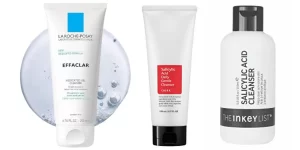
Do I need sunscreen if my moisturizer has SPF?
When it comes to protecting your skin from the sun’s harmful effects, there are various options available, including wearing sunscreen or using a moisturizer with SPF.
Do both options provide the same level of protection?

As with everything, there are advantages and disadvantages to each approach.
Let’s explore the impact of wearing sunscreen versus a moisturizer with SPF on your skin’s health and discuss the benefits of each approach.
Understanding sunscreen and moisturizer with SPF
Sunscreen provides skin protection from harmful UV rays by blocking or absorbing them.
SPF, or Sun Protection Factor, is a measure of the amount of protection the product provides.
Moisturizer with SPF is a moisturizing product that also provides protection from the sun.
The key difference between sunscreen and moisturizers with SPF is the amount of protection they provide.
Sunscreen typically has a higher SPF rating than moisturizers with SPF, making it more effective in blocking UV rays.
3 Advantages of wearing sunscreen over moisturizers with SPF
Wearing sunscreen has several advantages over just using a moisturizer with SPF.
- Higher SPF rating: Sunscreen typically has a higher SPF rating compared to moisturizers with SPF, providing greater protection from the sun’s harmful UV rays.
- Broader protection: Sunscreen provides protection from both UVA and UVB rays, while some moisturizers with SPF only protect against UVB rays.
- Consistent coverage: Sunscreen is typically applied evenly, providing consistent protection across the entire face and exposed skin.
Sunscreen tip:
Be sure to choose a sunscreen with an SPF rating of 30 or higher and apply enough to cover your entire face and exposed skin.
For optimal protection, reapply sunscreen every two hours, or immediately after sweating or swimming.
Following these tips, you can effectively protect your skin from the sun’s harmful effects and maintain healthy, glowing skin.

2 Disadvantages of choosing a moisturizer with SPF:
While a moisturizer with SPF can be more convenient, it also has its disadvantages; namely, it typically has a lower SPF rating compared to sunscreen.
- It probably won’t provide enough protection from the sun, especially if you have fair skin or spend extended periods in the sun.
- If you don’t apply it evenly you’ll have missed areas and reduced protection.
6 Healthy skin tips when using sunscreen
1. Wear sunscreen every day, regardless of the weather or season.
Whether it’s a cloudy or hot summer day, it’s important that you apply sunscreen every day.
Not only will you be protecting your skin from harmful UV rays, but you’ll also be reducing your risk of skin cancer and premature aging.
2. Choose a broad-spectrum sunscreen that offers protection from UVA and UVB rays.
When it comes to protecting your skin from the harmful effects of the sun, choosing the right sunscreen is a must.
Broad-spectrum sunscreens are specifically designed to protect against both UVA and UVB rays, providing a complete solution for sun protection.
Investing in a broad-spectrum sunscreen is one of the best ways to ensure that your skin remains protected from the damaging effects of the sun.
3. Apply sunscreen generously before going outside, even on cloudy days.
Use sunscreen every day yes, even on cloudy days.
Applying it generously and regularly can help guard against sunburn, wrinkles, age spots, and other skin damage.
Don’t forget to reapply often throughout the day and make sure to choose a sunscreen with an SPF of at least 30 for optimal protection.
4. Reapply sunscreen after swimming or sweating.
Sunscreen helps protects your skin from harmful UV rays and prevents sunburns, however, it’s not enough to just apply sunscreen once; especially if you’re spending the day at the beach or an outdoor pool.
In this case, you need to reapply it every two hours, or immediately after you get out of the water.
This ensures that your skin is properly protected throughout the day and you can happily enjoy yourself without worrying about sun damage.
5. Make sure to use sunscreen on all exposed skin, including your scalp, face, neck, ears and the tops of your feet.
If it’s a hot sunny day and you’re going to spend a lot of time outside, cover everything in sunscreen (maybe not everything, but you get the idea). This includes your face, neck, ears and the tops of your feet.
This can help you avoid sunburns and other serious health issues down the road.
6. Cover up when possible.
This next tip might not work well if you’re spending the day at the beach but some things will still apply. Sunscreen is great but don’t rely solely on just that.
Wear protective clothing whenever it makes sense. This could mean wearing lightweight long-sleeved shirts and wide-brimmed hats if it’s a super hot day and is an easy way to guard your skin against the sun.
Not only does this help keep you safe from potential skin damage, but it can also help reduce the risk of heat exhaustion and dehydration.
So don’t forget to wear sunscreen and cover up the next time you head outdoors on a hot sunny day.
Final thoughts
In terms of impact on your skin’s health, using a moisturizer and sunscreen separately is the better option.
A moisturizer with SPF is convenient in the short term, yes, but it won’t benefit your skin in the long run.
Using a separate sunscreen will provide better protection against the sun’s harmful UV rays.
Moisturizers with SPF often have a lower SPF rating compared to standalone sunscreens.
So they don’t give enough protection from the sun.
Some moisturizers with SPF only protect against UVB rays, completely ignoring UVA rays, which cause long-term damage to the skin.
By using a separate sunscreen, you can choose one with a higher SPF rating and protection against both UVA and UVB rays, providing a more complete and effective solution for sun protection.
Furthermore, applying a separate sunscreen allows you to customize the amount and frequency of application based on your specific sun exposure, ensuring maximum protection for your skin.
FAQs
Should you use moisturizers with SPF?
You can use moisturizers with SPF, but they probably won’t provide enough protection compared to standalone sunscreens.
Here are a few reasons why:
- Lower SPF rating: Moisturizers with SPF often have a lower SPF rating than standalone sunscreens, meaning they don’t provide enough protection from the sun.
- Limited protection: Some moisturizers with SPF only protect against UVB rays, while ignoring UVA rays, which can cause long-term damage to your skin.
- Inconsistent coverage: If you don’t apply moisturizers with SPF evenly or in sufficient amounts, you will leave some areas of your skin unprotected from the sun’s rays.
While moisturizers with SPF can provide some level of sun protection, it’s better to use a separate, high-quality sunscreen for maximum protection against the sun’s harmful rays.

Can I skip sunscreen after moisturizer?
Yes, you can, but you shouldn’t. You should never skip using sunscreen after moisturizer. Always use sunscreen!
Moisturizers with or without SPF won’t provide nearly enough protection against UVA and UVB rays, especially if you are spending extended periods in the sun.
Can I use just an SPF moisturizer?
Yes, you can use just an SPF moisturizer; however, your skin won’t get complete protection from the sun’s harmful rays.
Therefore, you should still wear broad-spectrum sunscreen with an SPF of at least 30.
How long should I let my moisturizer absorb before sunscreen?
There is no hard and fast rule for how long to wait, as the time will vary from person to person.
You wait as long as you need to for your moisturizer to dry – that’s it!



